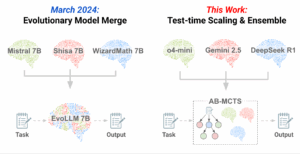Don't Want AI to Do Everything: Stanford Study Surveys 1,500 US Workers
I'm Tak@, a system integrator who runs IT Explore. I'm passionate about web service development and constantly explore the possibilities of generative AI. In this column, I'll share some fascinating research findings on AI's impact on work that challenge common perceptions. Will AI take our jobs, or will it open new avenues for collaboration? Hints from Stanford University's latest research shed light on these questions.
What Workers Want AI For—And What They Don't
The rapid advancement of AI technology is bringing significant changes to the labor market. Many may worry about AI taking over their jobs. However, a new database called "WORKBank," published by Stanford University researchers, offers a more complex and human-centric perspective on the future of AI and work.
This study gathered opinions on 844 tasks from 1,500 on-the-ground workers across 104 occupations and 52 AI experts, all based on the U.S. Department of Labor's O*NET database. It employs an innovative framework that moves beyond a simple "automate or not" dichotomy. Instead, it evaluates what workers want AI agents to automate, what they want them to augment (enhance human capabilities), and how well that aligns with current technological capabilities.
Tasks Workers "Strongly Desire" AI to Automate
Interestingly, in 46.1% of the surveyed tasks, workers expressed a positive attitude towards automation by AI agents. Their primary reason for desiring automation was to "spend time on more valuable work," accounting for 69.38% of responses. Other reasons included tasks being repetitive and boring (46.6%), stressful (25.5%), or offering opportunities for quality improvement (46.6%).
For example, the task "Tax Preparer: Scheduling appointments with clients" showed a high desire for automation, averaging 5.00 points (highly desire automation). This clearly indicates that workers want to be freed from routine, time-consuming tasks to focus on more strategic and human-centric duties. I've personally experienced the benefits of AI collaboration by using an "AI Learning Planner" tool to boost my study efficiency.
However, looking at the current usage of LLMs (Large Language Models), there's a "mismatch" between workers' desire for automation and actual AI utilization. For instance, the top 10 occupations with the highest automation desire account for only 1.26% of the total usage of the LLM-based chatbot "Claude.ai." This suggests that existing usage patterns are concentrated among certain early adopters and occupations, and the broader potential needs of workers are not yet fully reflected.
Tasks Requiring "Human Touch" That Workers Don't Want AI to Handle
On the other hand, there are tasks where workers show resistance to AI automation. Analysis of audio responses revealed that 28.0% of respondents expressed concerns or negative feelings regarding AI use. Key concerns included:
- Distrust in the accuracy, capabilities, and reliability of AI systems (45.0%)
- Fear of job displacement by AI (23.0%)
- Lack of "human touch" or human capabilities in AI (16.3%)
When discussing this lack of "human touch," workers expressed desires to maintain human interaction in their work, reduce creative control, and preserve their agency in decision-making.
Particularly in the "Art, Design, and Media" sector, there was significant resistance to the automation of content creation, with only 17.1% of tasks in this field receiving positive evaluations for automation. One art director explicitly stated, "I would use AI to make my workflow more seamless and to reduce repetitive and boring tasks. I would not use it to create content."
Furthermore, "Editors" were the only occupation where workers most desired "H5 (continuous human involvement is essential)." This suggests they consider human intervention indispensable for the creativity and nuanced judgment involved in content.
The Potential for AI-Human "Collaboration": The Human Agency Scale (HAS)
A crucial aspect of this research is the introduction of the "Human Agency Scale (HAS)" to move beyond the traditional binary view of "automation or not." This scale quantifies the degree of human involvement required for task completion and quality, ranging from H1 (no human involvement) to H5 (continuous human involvement is essential).
- H1: AI agent handles the task entirely autonomously.
- H2: AI agent requires minimal human input for optimal performance.
- H3: AI agent and human work in equal partnership, achieving better outcomes than either alone.
- H4: AI agent requires human input to successfully complete the task.
- H5: AI agent cannot function without continuous human involvement.
HAS provides a human-centered perspective for evaluating both task characteristics and appropriate AI agent development approaches. Tasks in H1-H2 are suitable for automation, while tasks in H3-H5 can benefit from augmentation strategies.
Expectations for "Equal Partnership"
Surprisingly, the HAS survey results indicate that H3 (AI agents and humans working in equal partnership, achieving better outcomes than either alone) is the most desired level for workers in 45.2% of occupations. This strongly suggests that many workers view AI not as a job-stealing entity, but as a complementary and enhancing force—a "collaborative partner."
Analysis of audio responses also shows that the majority of workers are positive about collaborating with AI. The most common form of collaboration is "role-based AI support" (23.1%), where AI is expected to take on specific roles or personalized functions. The next most common is "AI as an assistant" (23.0%), with a shared image of AI as an "assistant who can conduct research on behalf of others." This research suggests that AI agent and human "collaboration" has the potential to not only improve productivity but also enhance work quality and positively impact worker creativity and satisfaction.
However, a "mismatch" still exists between the level of human involvement workers desire (Hw(t)) and the technically feasible level assessed by AI experts (He(t)). Only 26.9% of all tasks show agreement between both evaluations, and workers generally tend to desire a higher level of human involvement than what experts consider technically possible. This divergence of opinion is stated to foreshadow potential friction as AI adoption progresses.
The "Mismatch" in Investment and Research Reveals Opportunities
The WORKBank data combines workers' "desire for automation" (Aw(t)) with AI experts' assessment of "current technical feasibility" (Ae(t)) to categorize tasks into four zones:
- Automation "Green Light" Zone: Tasks with both a high desire for automation and high current technical capability. These have the potential for widespread productivity gains and social benefits, making them prime candidates for AI agent deployment.
- Automation "Red Light" Zone: Tasks with high technical capability but low desire for automation. These may face worker resistance upon introduction or have broad negative social implications, requiring careful consideration.
- R&D Opportunity Zone: Tasks with a high desire for automation but low current technical capability. These represent promising directions for future AI research and development.
- Low Priority Zone: Tasks with both low desire for automation and low current technical capability. These are considered less urgent for AI agent development.
This categorization reveals an unexpected "mismatch." For instance, in "Y Combinator (YC) company task mapping," which measures investment in startups, 41.0% of investment is concentrated in the "Low Priority Zone" and "Automation Red Light Zone." This suggests that current investments may be flowing into areas different from where workers desire AI implementation. Current investment primarily focuses on software development and business analysis, overlooking many promising tasks in the "Green Light Zone" and "R&D Opportunity Zone."
Conversely, research papers on AI agents tend to focus on the "R&D Opportunity Zone." While this is positive, this research is still concentrated in computer science and engineering fields, indicating a need for broader research across various domains.
This "mismatch" provides crucial insights for aligning societal needs with the direction of technological development. Directing more research, development, and investment towards where AI is truly needed – in areas desired by workers – will be essential for building a society where AI and humans coexist.
Shifting "In-Demand Skills" in the AI Era
How will the integration of AI agents change the demand for core human capabilities, or "skills"? The research captures signs of this shift by linking tasks to O*NET skills (generalized work activities).
From "Information Processing" to "Interpersonal Skills"
Notably, skills previously emphasized in high-wage occupations, such as "analyzing data or information" and "updating and using relevant knowledge," have become relatively less important in tasks requiring AI collaboration. Instead, the importance of "interpersonal skills" and "organizational skills" related to human interaction, coordination, and resource monitoring has increased.
This suggests that while AI efficiently handles data processing and analysis, humans will shift their value to areas difficult for AI, such as building complex human relationships ("establishing and maintaining interpersonal relationships"), empathy ("assisting and caring for others"), mentoring ("coaching, directing, and motivating subordinates"), creative thinking ("creative thinking"), and ethical judgment.
For example, H5 level tasks (tasks requiring continuous human involvement) are strongly associated with "interpersonal communication" in worker evaluations, while expert evaluations emphasize both "interpersonal communication" and "professional knowledge". This shift will also impact the direction of education and vocational training. In the future labor market, not just knowledge and information processing abilities, but uniquely human "soft skills" will become even more valuable.
Conclusion: Co-creating a Future with AI
The Stanford University WORKBank survey has provided valuable data that enriches our understanding of the future of AI and work. The rise of AI isn't just about the threat of "automation or unemployment"; it offers hope that we can open new paths of "augmentation" by carefully aligning workers' needs with technological possibilities.
Workers desire to delegate boring, low-value tasks to AI, freeing up their time for more creative and valuable work. And for many tasks, they expect an "equal partnership" with AI.
However, the current direction of investment and research and development doesn't always align with these worker needs. Recognizing this "mismatch" and listening to workers' voices will be key to developing AI responsibly and "co-creating" better ways of working in the future.
AI is a tool that will "change" our work, and we ourselves must evolve through our interaction with AI. The shift in skills from information processing to interpersonal abilities indicates a concrete direction for this evolution. We can strategically leverage AI to maximize human value and build a future where we thrive alongside it.



